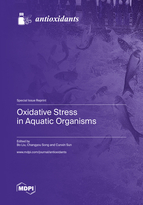Oxidative Stress in Aquatic Organisms
A special issue of Antioxidants (ISSN 2076-3921).
Deadline for manuscript submissions: closed (25 November 2022) | Viewed by 62954
Special Issue Editors
Interests: aquatic nutrition; nutriomics; oxidative stress; signal pathway; epigenetic regulation
Interests: aquatic animal nutrition; antioxidant regulation; immune response; lipid metabolism; muscle regeneration; intestinal health
Interests: aquaculture nutrition; fish and shellfish; molecular mechanism; antioxidants; stress factor; antioxidant approach
Special Issues, Collections and Topics in MDPI journals
Special Issue Information
Dear Colleagues,
Oxidative stress mainly refers to the imbalance between reactive oxygen species production and antioxidant defense systems in organisms. Excessive oxidative stress could induce cell and tissue damage, mainly manifested as DNA hydroxylation, protein denaturation, lipid peroxidation and cell apoptosis. In the past few decades, aquaculture has developed rapidly and has become the fastest growing food production sector for humans. Oxidative stress is ubiquitous in aquatic animals. In general, endogenous and exogenous factors are the main elements that induce oxidative stress, including temperature, oxygen, life history, nutrition, food deprivation, industrial and agricultural pollutants, etc. In accordance with other animals, aquatic organisms have evolved complex mechanisms to resist oxidative stress. Therefore, to uncover the causes of oxidative stress, elucidate the underlying physiological mechanisms, and develop antioxidant strategies are of great importance for the development of aquaculture.
This Special Issue aims to collect papers dealing with all aspects of oxidative stress response in aquatic animals, including the generation process, the response mechanism and the resistant approaches. In order to provide an updated overview of the advances in oxidative stress research in aquatic animals, papers describing recent developments with advanced molecular approaches in both living organisms and habitats will be especially welcome.
Please note: An article processing charge (APC) of 2000 CHF currently applies to each accepted paper. For papers submitted after 31 December 2021 an APC of 2200 CHF applies.
Dr. Bo Liu
Dr. Changyou Song
Dr. Cunxin Sun
Guest Editors
Manuscript Submission Information
Manuscripts should be submitted online at www.mdpi.com by registering and logging in to this website. Once you are registered, click here to go to the submission form. Manuscripts can be submitted until the deadline. All submissions that pass pre-check are peer-reviewed. Accepted papers will be published continuously in the journal (as soon as accepted) and will be listed together on the special issue website. Research articles, review articles as well as short communications are invited. For planned papers, a title and short abstract (about 100 words) can be sent to the Editorial Office for announcement on this website.
Submitted manuscripts should not have been published previously, nor be under consideration for publication elsewhere (except conference proceedings papers). All manuscripts are thoroughly refereed through a single-blind peer-review process. A guide for authors and other relevant information for submission of manuscripts is available on the Instructions for Authors page. Antioxidants is an international peer-reviewed open access monthly journal published by MDPI.
Please visit the Instructions for Authors page before submitting a manuscript. The Article Processing Charge (APC) for publication in this open access journal is 2900 CHF (Swiss Francs). Submitted papers should be well formatted and use good English. Authors may use MDPI's English editing service prior to publication or during author revisions.
Keywords
- aquatic animals
- oxidative stress
- regulatory mechanism
- resistant approach
- stress biomarker









